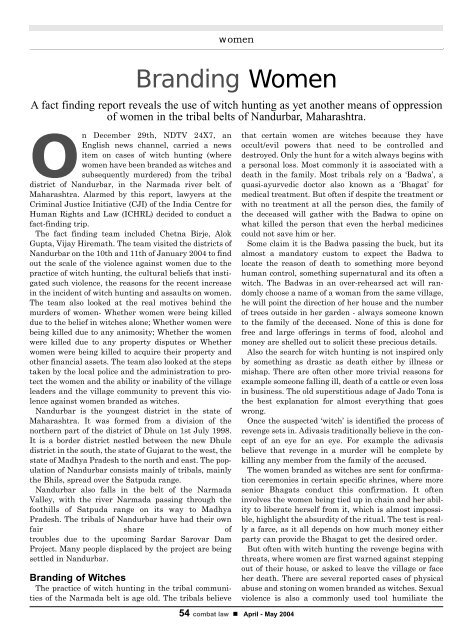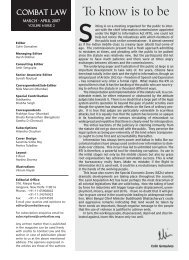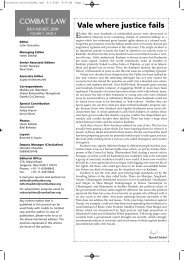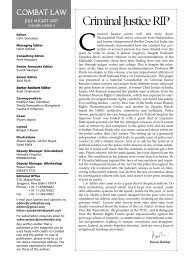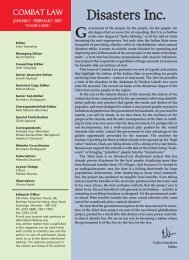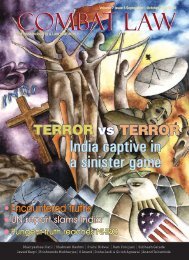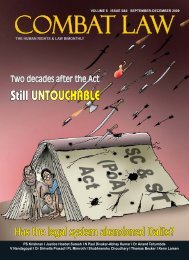PDF, 1.1MB - Combat Law
PDF, 1.1MB - Combat Law
PDF, 1.1MB - Combat Law
Create successful ePaper yourself
Turn your PDF publications into a flip-book with our unique Google optimized e-Paper software.
womenBranding WomenA fact finding report reveals the use of witch hunting as yet another means of oppressionof women in the tribal belts of Nandurbar, Maharashtra.On December 29th, NDTV 24X7, anEnglish news channel, carried a newsitem on cases of witch hunting (wherewomen have been branded as witches andsubsequently murdered) from the tribaldistrict of Nandurbar, in the Narmada river belt ofMaharashtra. Alarmed by this report, lawyers at theCriminal Justice Initiative (CJI) of the India Centre forHuman Rights and <strong>Law</strong> (ICHRL) decided to conduct afact-finding trip.The fact finding team included Chetna Birje, AlokGupta, Vijay Hiremath. The team visited the districts ofNandurbar on the 10th and 11th of January 2004 to findout the scale of the violence against women due to thepractice of witch hunting, the cultural beliefs that instigatedsuch violence, the reasons for the recent increasein the incident of witch hunting and assaults on women.The team also looked at the real motives behind themurders of women- Whether women were being killeddue to the belief in witches alone; Whether women werebeing killed due to any animosity; Whether the womenwere killed due to any property disputes or Whetherwomen were being killed to acquire their property andother financial assets. The team also looked at the stepstaken by the local police and the administration to protectthe women and the ability or inability of the villageleaders and the village community to prevent this violenceagainst women branded as witches.Nandurbar is the youngest district in the state ofMaharashtra. It was formed from a division of thenorthern part of the district of Dhule on 1st July 1998.It is a border district nestled between the new Dhuledistrict in the south, the state of Gujarat to the west, thestate of Madhya Pradesh to the north and east. The populationof Nandurbar consists mainly of tribals, mainlythe Bhils, spread over the Satpuda range.Nandurbar also falls in the belt of the NarmadaValley, with the river Narmada passing through thefoothills of Satpuda range on its way to MadhyaPradesh. The tribals of Nandurbar have had their ownfair share oftroubles due to the upcoming Sardar Sarovar DamProject. Many people displaced by the project are beingsettled in Nandurbar.Branding of WitchesThe practice of witch hunting in the tribal communitiesof the Narmada belt is age old. The tribals believethat certain women are witches because they haveoccult/evil powers that need to be controlled anddestroyed. Only the hunt for a witch always begins witha personal loss. Most commonly it is associated with adeath in the family. Most tribals rely on a ‘Badwa’, aquasi-ayurvedic doctor also known as a ‘Bhagat’ formedical treatment. But often if despite the treatment orwith no treatment at all the person dies, the family ofthe deceased will gather with the Badwa to opine onwhat killed the person that even the herbal medicinescould not save him or her.Some claim it is the Badwa passing the buck, but itsalmost a mandatory custom to expect the Badwa tolocate the reason of death to something more beyondhuman control, something supernatural and its often awitch. The Badwas in an over-rehearsed act will randomlychoose a name of a woman from the same village,he will point the direction of her house and the numberof trees outside in her garden - always someone knownto the family of the deceased. None of this is done forfree and large offerings in terms of food, alcohol andmoney are shelled out to solicit these precious details.Also the search for witch hunting is not inspired onlyby something as drastic as death either by illness ormishap. There are often other more trivial reasons forexample someone falling ill, death of a cattle or even lossin business. The old superstitious adage of Jado Tona isthe best explanation for almost everything that goeswrong.Once the suspected ‘witch’ is identified the process ofrevenge sets in. Adivasis traditionally believe in the conceptof an eye for an eye. For example the adivasisbelieve that revenge in a murder will be complete bykilling any member from the family of the accused.The women branded as witches are sent for confirmationceremonies in certain specific shrines, where moresenior Bhagats conduct this confirmation. It ofteninvolves the women being tied up in chain and her abilityto liberate herself from it, which is almost impossible,highlight the absurdity of the ritual. The test is reallya farce, as it all depends on how much money eitherparty can provide the Bhagat to get the desired order.But often with witch hunting the revenge begins withthreats, where women are first warned against steppingout of their house, or asked to leave the village or faceher death. There are several reported cases of physicalabuse and stoning on women branded as witches. Sexualviolence is also a commonly used tool humiliate the54 combat law • April - May 2004


